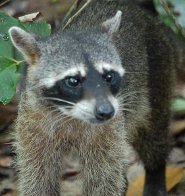 The Crab-Eating Raccoon (Procyon cancrivorus) is smoother and lighter than its northern cousins. The males of this species are polygynous, which means they mate with several females from July to September of each year. The females, however, will not allow another male to mate with them after they have become pregnant. This leaves the males free to seek out other partners for the rest of the season. North American raccoons mate from January to June when the weather is rather cold. Their options for partners are somewhat more limited in this environment. So, Procyron cancrivorus is not only more attractive than Procyon lotor; he also gets a more exciting lifestyle in much better weather. This is why the Crab-Eating Raccoon could be nicknamed the sleek South American playboy of the raccoon world.
The Crab-Eating Raccoon (Procyon cancrivorus) is smoother and lighter than its northern cousins. The males of this species are polygynous, which means they mate with several females from July to September of each year. The females, however, will not allow another male to mate with them after they have become pregnant. This leaves the males free to seek out other partners for the rest of the season. North American raccoons mate from January to June when the weather is rather cold. Their options for partners are somewhat more limited in this environment. So, Procyron cancrivorus is not only more attractive than Procyon lotor; he also gets a more exciting lifestyle in much better weather. This is why the Crab-Eating Raccoon could be nicknamed the sleek South American playboy of the raccoon world.Crab-Eating Raccoons inhabit central and south America. They prefer to live near bodies of water in parts of Argentina, Paraguay, Uruguay, and Costa Rica. Procyon cancrivorus does seem to prefer marshy and swampy inland rivers. The Crab-Eating Raccoon can make use of just about any habitat, though, as long as there are adequate opportunities to find food, water, and shelter.
Interestingly, the Crab-Eating Raccoon usually seems to prefer to eat fruit. Of course, like all raccoons, these animals will eat anything they can find: nuts, insects, amphibians, fish, and of course, crabs.
Crab-Eating Raccoons weigh between 3 and 7 kg (about 6-15 pounds). They are usually 54 to 65 centimeters in length (approximately 21-26 inches), including the tail. The tail comprises nearly half of the animal's total length. These anmimals can fall prey to any larger carnivore. Sometimes even owls and alligators will kill them for food. Humans may hunt them for their fur. The species is not threatened or endangered at this point, though it has received some attention from international associations. One famous orphaned crab-eating raccoon named Bandit resides at the Karanambu ranch in Guyana.
Picture of the crab-eating raccoon by Steven G. Johnson, licensed under Creative Commons Attribution-Share Alike 3.0 Unported
Keywords: ringed tail , tail
The Crab-eating raccoon is listed as Least Concern (LR/lc), lowest risk. Does not qualify for a more at risk category. Widespread and abundant taxa are included in this category, on the IUCN Red List of Threatened Species
Namings for the crabeating raccoon
A young / baby of a crabeating raccoon is called a 'kit'. The females are called 'sow' and males 'boar'. A crabeating raccoon group is called a 'nursery'.Countries
Argentina, Bolivia, Brazil, Colombia, Costa Rica, Ecuador, French Guiana, Guyana, Panama, Paraguay, Peru, Suriname, Trinidad and Tobago, Uruguay and VenezuelaCrab-eating raccoon habitats
Bogs, Marshes, Swamps, Fens, Peatlands, Forest, Permanent Rivers / Streams / Creeks (includes waterfalls), Subtropical / Tropical Mangrove Vegetation Above High Tide Level and Wetlands (inland)Some facts about the
Crab-eating raccoon
Adult weight : 6.27 kg (13.794 lbs)
Maximum longevity : 19 years
Female maturity :365 days
Male maturity : 365 days
Gestation : 63 days
Litter size : 3
Weight at birth : 0.071 kg (0.1562 lbs)
Basal metabolic rate : 3 W
Body mass : 1.16 kg (2.552 lbs)
Temperature : 36.85 °C (98.33 °F)

Custom Search